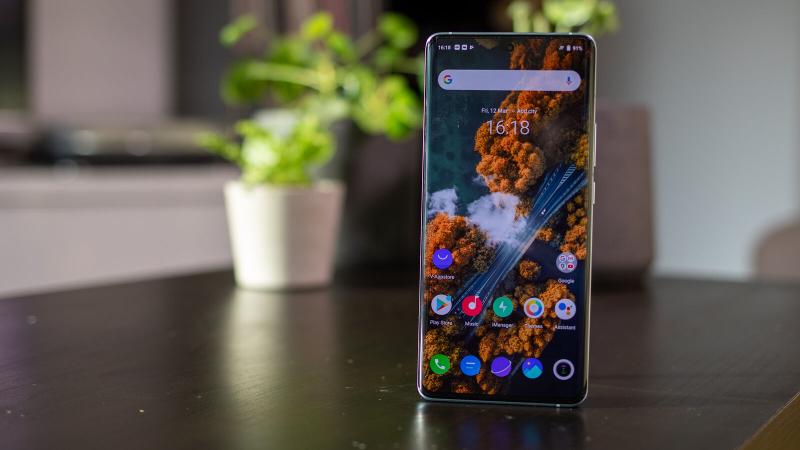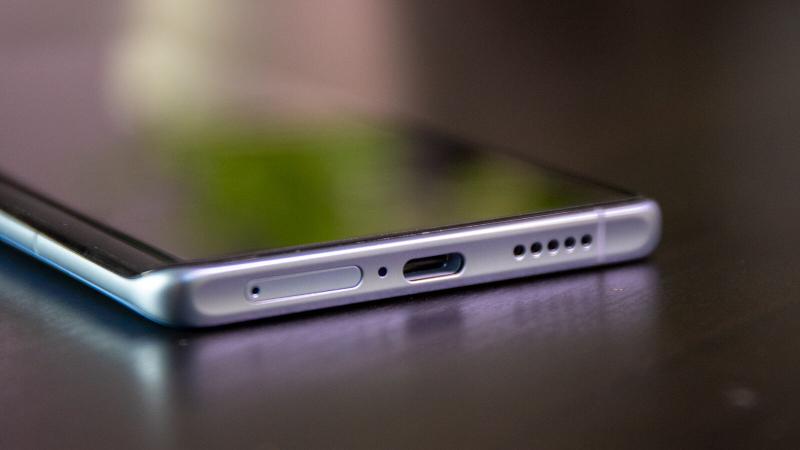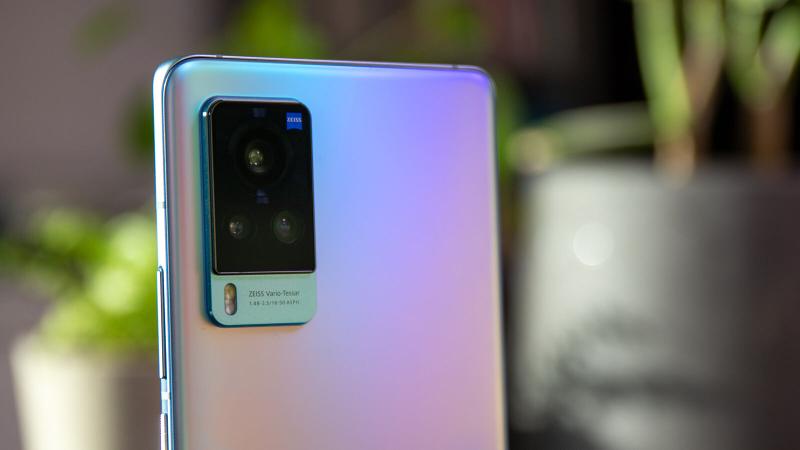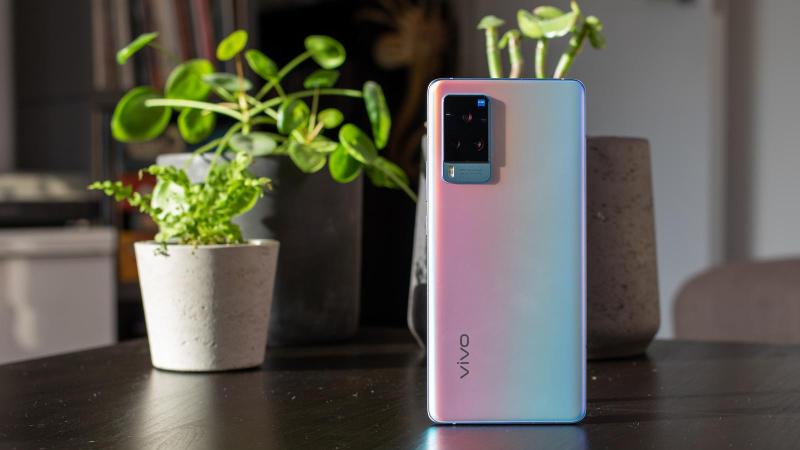The Vivo X60 Pro is, for now, the only phone in the company’s X60 series available to buy in the UK and western Europe.
The follow-up to last year’s X50 Pro – released here as the X51 – is a camera-focused flagship that makes small compromises on its chipset and charging capabilities in order to deliver a top-tier camera and one of the smallest, lightest flagship phone designs I can remember.
Design and build
I wrote last year that Vivo is probably making the best looking phones in the industry right now, and that hasn’t changed.

The X60 Pro is an absolute looker. My ‘Shimmer Blue’ model is obviously an eye-catcher, reflecting a whole spectrum of colours depending on how it catches the light, but if you prefer something more subtle the phone comes in black too.
More than the colour though, it’s the build that Vivo has nailed. Despite the generous 6.56in display the X60 Pro is remarkably svelte and lightweight. It’s either 7.6/7.7mm thick, and weighs just 177/179g (the blue model is, curiously, a fraction thicker and heavier).
In either case, that makes this one of the lightest and slimmest phones of the year while still offering a large display, and I only wish more manufacturers would pay attention. The feel of the phone is fantastic too, with comfortably curved edges and a strangely appealing softness to the frosted glass finish.

The X60 Pro also marks the return of Vivo’s stepped camera module, an attractive design touch that I’m a fan of. It simultaneously draws attention to the lens array while making it feel slimmer and more compact than it really is – a clever piece of design.
Otherwise, the X60 Pro’s design is fairly straightforward. The power and volume buttons sit on the right rail, with USB-C along the bottom.
There’s no headphone jack, and no IP rating for waterproofing. The haptics also feel a little cheap and rattle-y, but these are ultimately fairly small complaints. The X60 Pro looks and feels fantastic, even surpassing the majority of flagship rivals.
Display
As much as you may want to appreciate how your phone looks, you’ll spend more time staring at the display. Luckily, Vivo has a solid offering here, though admittedly not quite class-leading.

The 6.56in display is a curved AMOLED, and supports 120Hz refresh rate, which makes the whole phone feel smoother in use, supported by a 240Hz touch sampling rate for faster gaming. Colours are deep and rich, and contrast is impressive – simply put, it looks great.
As you’d expect now, the display also houses the phone’s fingerprint sensor, which works like a treat.
There are only really two compromises here. One is that unlike a few high-end phone displays this year, the X60 Pro doesn’t support a true dynamic refresh rate, so it can only cycle between 60Hz or 120Hz. That denies you the power-saving potential of other panels, which can refresh slower when appropriate.
Perhaps more importantly, the display is only Full HD+ resolution, while some similarly priced rivals offer higher resolution QHD+ panels. For most people this really won’t matter – the higher pixel density is very difficult to spot in screens this size anyway – but if you’re weighing up the X60 Pro vs other flagships, this is one of the compromises here.
Specs and performance
Specs is another area where Vivo has made an interesting compromise. Instead of the top-tier Snapdragon 888 chipset found in most 2021 flagships – including the X60 Pro+ – the X60 Pro is powered by the Snapdragon 870.
This is essentially an over-clocked version of last year’s flagship chip, the 865, and is itself a replacement for the Samsung Exynos 1080 chipset that the X60 and X60 Pro use in China. That’s all a bit inside baseball though, so here’s what really matters: you still get 5G and you still get incredible performance, even if it’s not technically the best performance around.
You can see from the benchmarks that the X60 Pro still essentially keeps pace with the rest of 2021 flagship cohort, along with a huge leap forward from last year’s X50 Pro. Note though that the higher framerates on the graphical benchmarks are in part thanks to the lower resolution panel compared to the Xiaomi Mi 11 and Oppo Find X3 Pro.
The X60 Pro ships with 12GB RAM and 256GB storage. That RAM count is enhanced slightly by new ‘extended RAM’ software, which essentially allocates un-used storage space as temporary RAM when needed, effectively giving the phone an additional 3GB. It’s hard in testing to assess how much this really helps, but I can at least say that the phone handles multitasking with aplomb – the main time RAM gets strained – so something’s going right at least.
Battery and charging
If there’s a weak spot to the X60 Pro, it’s really here. The battery life itself is essentially average for a flagship – it should last the day most of the time, but it will be running a little low by the time it gets there. That’s good enough, but it’s not great.

Wired charging is capped at 33W, which was enough to top the battery up to 62% in half an hour. That’s faster than you’ll get from Samsung or Apple for the most part, but rivals around this price now often deliver 65W speeds or even faster, and in fact you can find faster charging than this on some budget phones this year.
Just as importantly, this is now one of the few flagship phones that doesn’t offer any wireless charging at all. This is definitely a convenience feature, but at this point it really is expected in a phone this price, and Vivo is long overdue offering wireless support.
Camera
The X60 Pro packs in an impressive triple camera setup, with a main lens, ultrawide, and 2x zoom portrait camera – all bolstered by Zeiss branding. You might have seen elsewhere that it includes a 5x periscopic zoom lens, but unfortunately this is only included in the Chinese release of the phone, not the international version.
The involvement of Zeiss is a little hard to pin down here. Beyond the logo, and the inclusion of a Zeiss-branded ‘Biotar’ portait mode, with a circular bokeh effect, Vivo doesn’t point to any specific Zeiss contributions to the camera. Instead, it says Zeiss has helped it test and refine its optical tech, and ensured that the cameras have met Zeiss’s own standards for certification.

In any case, the highlight here is the main lens, by a comfortable margin. This 48Mp camera has an exceptional aperture of f/1.5, and is supported by the second generation of Vivo’s own gimbal stabilisation system.
The large aperture helps the camera bring in as much light as possible, while the gimbal tech – which essentially moves the whole lens around to counteract hand shake – helps to improve HDR and preserve detail in stills.

The result is that in good to dim light the main camera produces sharp, detailed photographs and does a great job at white balance and exposure, managing bright spots and shadows equally well. Colours skew a little bright – this is the popular over-saturated, Instagram-ready style, rather than an attempt to capture more natural tones. But if that’s what you’re after, there aren’t many phone cameras that will do a better job.
The ultrawide and portrait lens are 13Mp each, and while they’re both good there is a clear gap between them and the main lens. Colours aren’t perfectly consistent between the three, but they’re close enough for the most part. The bigger differences are in detail and dynamic range, where the ultrawide in particular can’t quite keep up with the main lens. Shadows tend to be deeper, details softer, and edges fuzzier.
The 2x zoom lens holds its own better here, and is surprisingly sharp. Admittedly you’ll find much longer zooms elsewhere this year, but this is enough for simple punching in – and the digital zoom, up to 20x, is much better than most equivalents. Note the zoomed in photos of play taken at a Euros 2020 match and note how sharp the shots are, only really struggling a touch with motion blur on the ball.

The 32Mp selfie camera is also impressive, with great detail and accurate white balance even in challenging light conditions, from late night to direct sunlight and glare.
Portrait mode is supported across the front-facing camera, main lens, and, unsurprisingly, the 2x portrait lens. Results are solid, with adjustable bokeh and beauty effects if you like them.
Night mode is supported across the full suite of lenses, though in fact it doesn’t add much – most of Vivo’s lowlight algorithm seems to have been incorporated into the main photo mode, so switching to Night mode will only help in the most challenging conditions. At times it even hurts – I found skin tones better balanced from the main mode than the dedicated night functionality.
In either case, lowlight photos are fine but Vivo still has work to do here. The main camera really pulls apart from the other lenses here – no surprise with both the aperture and gimbal working in its favour – but details are still soft and any light sources get blown out. With all the hardware at its disposal, Vivo needs to improve the post-processing to really make the most of it and keep up with the competition here.

Of course, the gimbal helps with video too, which can be recorded at up to 4K and 60fps. With five axis of stabilisation in play, this second generation of the gimbal tech proves its worth better than the X50 Pro’s first-gen version, and can now combine the gimbal with electronic stabilisation for even stronger results. If you shoot a lot of action-cam style video, or just film while you’re on the move, this will improve the stability of your footage.
Software
Vivo is in a strange position with its phone software right now. In China the company has retired Funtouch OS, its Android skin, and replaced it with a new, widget-heavy design called OriginOS.
This isn’t shipping on the phone worldwide though. I’ve been testing the global version, which still runs Funtouch, on top of Android 11. Funtouch is a pretty busy operating system, with plenty of custom Vivo apps, pre-installed bloatware, and the company’s clunky virtual assistant Jovi.

On the other hand, if you buy the phone in the UK or Europe you’ll actually get a slightly different software experience. For its European phones Vivo strips Funtouch back to the basics, bringing it much closer to Google’s stock Android experience and clearing away a lot of the unnecessary extras.
While I haven’t tested that on this phone, I have on other European Vivo devices, and there really is very little to complain about. It’s a slick, minimalist software experience that’s close to Google’s own.
Vivo has also promised three years of Android OS and security updates for the X60 Pro, which is excellent for the Android market. It has in the past been aggressive with its Android update schedule too, so I would expect fairly rapid updates to new Android versions when they’re available.
Price and availability
The X60 Pro is out now in the UK and Europe, along with China, India, and a few other Asian countries. It is unlikely to release in the US.

In Europe the X60 Pro costs £749/€799, the exact same that Vivo charges for last year’s X51.
In the UK, you can buy it from Box, Clove, eBuyer, and eFones, or check out our guide to where to buy the X60 Pro for the latest deals we’ve found.
The Chinese price of ¥4,498 and Indian price of ₹49,990 each convert to much less than the European price, around £500/€580/$680, making it better value for Indian buyers – or for Westerners willing to import from Ali Express or Amazon India.
The official European price puts it close to the Samsung Galaxy S21, Xiaomi Mi 11, and OnePlus 9. The X60 Pro is the only one of that set not to offer wireless charging, and the only one to use an older chipset. On the other hand, it’s the thinnest of the set, and almost as light as the S21 – which has a smaller display. The camera also holds its own, and if you buy it in Europe you’ll get the benefit of near-stock Android software.
Check out our pick of the best Vivo phones for more of the company’s own options, or our pick of the best Android phones right now for the rest of the competition.
Verdict
The X60 Pro is a confident flagship from Vivo, and one that makes interesting – and usually smart – compromises in order to accentuate its strengths.
Those are primarily its design and build – for my money pretty much the best of any flagship smartphone this year so far – and its camera module, where the main lens keeps up with the competition, and the gimbal stabilisation makes it the best of the lot for…
